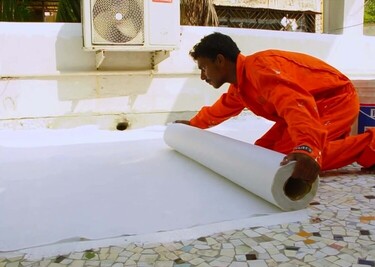If you own or manage an old residential building, especially one that has seen multiple monsoons, you know the top floor struggles are real. That persistent ceiling leak, the damp patches spreading across internal walls, and the continuous battle against mould—these are all symptoms of one core issue: compromised terrace waterproofing.
The terrace (or roof) is the most exposed part of any structure, bearing the full brunt of sun, rain, and thermal stress. For older buildings, neglecting this area isn’t just a minor maintenance oversight; it’s a direct threat to the building’s lifespan and the residents’ health.
At Zindus, we don’t just see a leak; we see a structural vulnerability. Here’s why investing in professional terrace waterproofing is the single smartest decision you can make for an old building.
The High Cost of Ignoring the Leak - Terrace Waterproofing is the Smartest Investment
A dripping ceiling is the final, most visible sign of a problem that has been brewing for years. When water penetrates the terrace slab, it initiates a domino effect of destruction:

1. The Threat to Structural Integrity
Water is the number one enemy of reinforced concrete. When it seeps through the slab, it reaches the reinforcement steel bars (rebar) embedded within the concrete.
- Corrosion: The rebar begins to rust. As steel rusts, it expands up to 6 times its original volume.
- Cracking and Spalling: This expansion creates immense internal pressure, leading to the concrete cracking, blistering, and finally, falling off (known as spalling).
- Weakened Structure: Spalling exposes more rebar, accelerating the corrosion cycle and reducing the load-bearing capacity of the beams and columns. This compromises the entire structure’s safety.
2. The Interior Damage Nightmare
Water doesn’t stop at the ceiling. It travels along the path of least resistance:
- Aesthetic Ruin: Causes unsightly damp patches, paint peeling, and discolouration on the ceiling and internal walls of the top-floor flats.
- Mould and Mildew: Damp walls become breeding grounds for mould and mildew, which release spores that can severely impact the indoor air quality, leading to respiratory issues and allergies for residents.
- Electrical Hazard: Water seepage near electrical conduits or wiring is a serious fire and shock hazard.
3. Escalating Repair Expenses
A small, timely waterproofing investment today is far cheaper than the extensive structural repairs required later. Ignoring the problem means paying for:
- Annual repainting of damp internal walls.
- Eventually, costly structural repairs like concrete jacketing or column strengthening.
- Potential legal disputes and devaluation of the property.
The Zindus Solution: Advanced Waterproofing Techniques
Modern waterproofing for old buildings is no longer about simply laying brickbat coba. The solutions used today are high-performance, flexible, and specifically designed for existing structures.
1. Identify and Correct Drainage Issues
Before any material application, the most common cause of standing water—improper slope (or gradient)—must be corrected. Water should drain efficiently, leaving no pooling areas on the terrace.
2. Crack Repair and Surface Preparation
- All existing structural cracks, pipe joints, and parapet wall corners are meticulously cleaned and sealed using epoxy-based injectables or polymer-modified mortars.
- The entire surface is cleaned thoroughly to ensure maximum adhesion for the new waterproofing layers.
3. The Power of High-Performance Membranes
For old buildings, a flexible, seamless solution is vital to accommodate the building’s movement and existing micro-cracks. We rely on top-tier systems:
Technique | Description | Key Benefit for Old Buildings |
Elastomeric Liquid-Applied Membrane | Applied like thick paint, these coatings cure into a seamless, highly elastic, and waterproof rubber layer. | Crack Bridging: Stretches with the building’s thermal expansion and contraction, preventing cracks from resurfacing. |
Polymer-Modified Cementitious Slurry | A blend of cement, sand, and special polymers applied in thin coats. | Positive Side Waterproofing: Excellent adhesion and chemical resistance, forming a strong, durable base barrier. |
Fibre-Reinforced Coatings | High-strength fibres embedded in the coating provide extra tensile strength and resistance against wear and tear. | Durability: Offers long-term mechanical protection and high resistance to foot traffic and UV rays. |
4. Solar Reflective Top Coats (Bonus Feature)
The final coat often uses a high Solar Reflective Index (SRI) paint (often white or light-coloured). This layer reflects sunlight, reducing the surface temperature of the terrace. This not only keeps the top-floor apartment cooler but also reduces the thermal stress on the slab, further protecting your waterproofing investment.
Seal the Deal: A Long-Term Investment
Terrace waterproofing isn’t an expense; it’s a fundamental part of the capital expenditure (CapEx) required to maintain and increase the value of your old building.
The Smart Investment Yields
Feature | Immediate Benefit | Long-Term Benefit |
Leak-Free Interiors | No more damp patches, peeling paint, or recurring repair bills for top-floor residents. | Prevents structural damage to the rebar, extending the building’s life. |
Healthier Environment | Eliminates dampness, mould, and mildew growth. | Protects residents from respiratory issues and improves indoor air quality. |
Increased Property Value | A structurally sound, leak-free building has higher resale value and better tenant appeal. | Reduces overall maintenance budget by eliminating the need for constant, temporary fixes. |
Don’t let water be the Achilles’ heel of your old structure. Seal the deal on safety, value, and health. Invest in a Zindus professional terrace waterproofing solution today and secure your building’s future.
